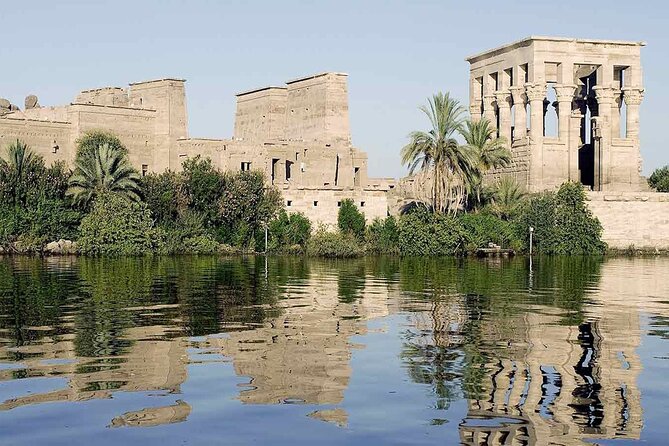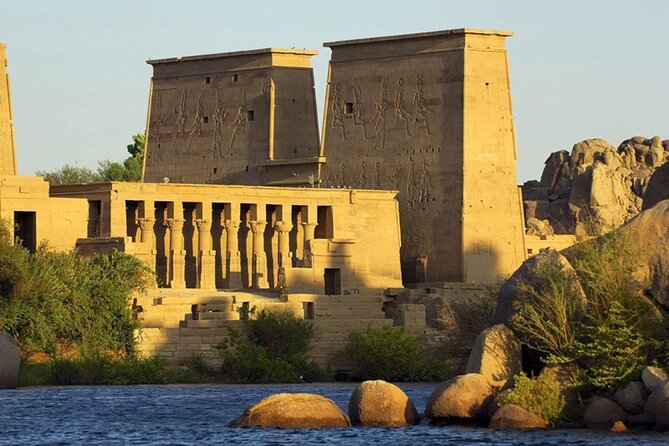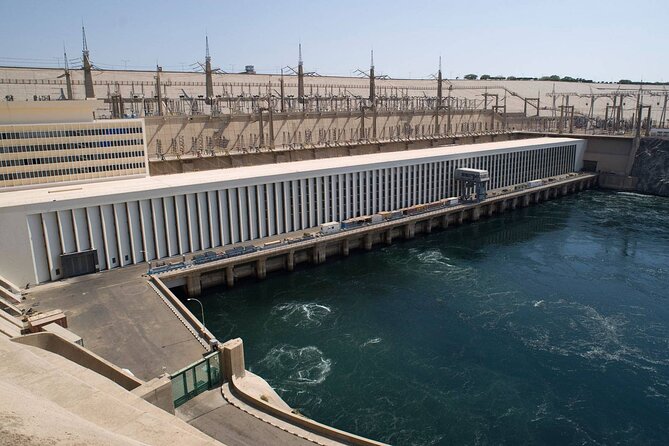Nestled along the tranquil Nile River, Aswan stands as a testament to Egypt’s fascinating history, with its storied past etched in the grandeur of the Philae Temple, the strategic engineering feat of the High Dam, and the ancient allure of the Unfinished Obelisk. The Philae Temple’s intricate carvings and imposing pylons beckon visitors to unravel the mysteries of ancient Egyptian religious practices, while the High Dam’s modern marvels offer a glimpse into the country’s contemporary ingenuity. What secrets lie within the Unfinished Obelisk’s unfinished form, waiting to be unveiled amidst Aswan’s ancient quarries?
Good To Know

- Philae Temple dedicated to Isis, showcases Ptolemaic-Roman architecture.
- Aswan High Dam regulates Nile, creates Lake Nasser, impressive engineering feat.
- Unfinished Obelisk reveals ancient quarry craftsmanship, abandoned due to crack.
- Aswan offers rich history, culture, Nubian Village, and authentic markets.
- Must-see attractions in Aswan: Philae Temple, High Dam, and Unfinished Obelisk.
Aswan’s Historical Significance

Aswan holds immense historical significance as a city that boasts a rich tapestry of ancient wonders and cultural heritage. Situated in southern Egypt, along the Nile River, Aswan has been a vital center of trade and civilization for centuries.
The city’s history is deeply intertwined with the construction of monumental structures such as the temples of Philae and the High Dam, showcasing the architectural prowess and engineering feats of ancient civilizations.
Aswan was also known for its granite quarries, where the famous Unfinished Obelisk remains a testament to the craftsmanship of the past.
Visitors to Aswan can enjoy the legacy of pharaohs, gods, and dynasties that have shaped this remarkable city into a treasure trove of historical marvels.
Find more activities and experiences we've covered in Aswan.
Philae Temple: A Sacred Site

Nestled on the tranquil island of Philae, the temple complex stands as a testament to ancient Egyptian religious devotion and architectural splendor. Dedicated to the goddess Isis, the Philae Temple was a center of pilgrimage and worship.
Built during the Ptolemaic and Roman periods, its structures showcase intricate carvings, majestic pylons, and elegant colonnades. The temple’s relocation due to the construction of the Aswan High Dam preserved it from the rising waters of Lake Nasser, allowing visitors to marvel at its grandeur today.
The Philae Temple’s significance extends beyond its stunning architecture; it represents the enduring spiritual beliefs of the ancient Egyptians and serves as a captivating reminder of their rich cultural heritage.
The High Dam: Engineering Marvel
The construction of the High Dam in Aswan marked a significant leap in engineering achievement and reshaped the landscape of the region. Completed in 1970, this massive structure stands at 111 meters tall and spans 3,830 meters in length, creating Lake Nasser, one of the largest man-made lakes in the world.
The High Dam plays a crucial role in regulating the Nile River’s annual flooding, providing water for irrigation and electricity through its hydroelectric power stations. Its construction required approximately 18 times more material than the Great Pyramid of Giza and was a testament to human ingenuity and determination.
Visiting the High Dam offers a unique opportunity to witness firsthand the impact of modern engineering on both the environment and society in Egypt.
Unfinished Obelisk: Ancient Quarry
What fascinating historical remnants can be explored at the site of the Unfinished Obelisk in Aswan’s ancient quarry?
The Unfinished Obelisk stands as a testament to the incredible ancient Egyptian craftsmanship, offering visitors a glimpse into the monumental task of obelisk construction. Carved directly out of the bedrock, this massive obelisk provides insight into the techniques used by ancient Egyptian artisans.
Estimated to be around 42 meters long and weighing approximately 1,168 tons, the obelisk was abandoned due to a crack that occurred during its extraction. Visitors can marvel at the sheer size of the obelisk and imagine the immense effort required to create such a colossal monument, making it a must-see attraction for history enthusiasts and archaeology aficionados alike.
Tourism in Aswan: Must-See Attractions

Discover the captivating array of must-see attractions that Aswan has to offer visitors seeking a rich tapestry of history and culture.
Aswan, located in Egypt, boasts a stack of remarkable sites that attract travelers from all over the world. The Philae Temple, dedicated to the goddess Isis, stands as a magnificent example of ancient Egyptian architecture and religious significance.
The High Dam, a marvel of modern engineering, provides stunning views of Lake Nasser and plays a crucial role in controlling the Nile’s annual flooding.
Plus, the Nubian Village offers a unique cultural experience with vibrant colors, traditional crafts, and warm hospitality.
Aswan’s bustling markets, like the Aswan Bazaar, offer a taste of local life and a chance to purchase authentic souvenirs.
- Full Day Tour to Abu Simbel Temples From Aswan
- 4-Day 3-Night Nile Cruise From Aswan to Luxor With Balloon and Abu Simbel
- Abu Simbel Day Trip With Egyptologist Guide – Aswan
- Nile Cruise: Aswan-Luxor 4-Day 5-Star Boat With Entry Fees
- 4-Days Nile Cruise From Aswan to Luxor Including Abu Simbel and Hot Air Balloon
- Aswan Day Tour Visiting Philae Temple, Unfinished Obelisk and High Dam in Aswan
Exploring Philae Temple
Exploring the ancient marvel of Philae Temple in Aswan unveils a captivating journey through Egypt’s rich history and architectural splendor. Located on Agilika Island, this temple dedicated to the goddess Isis offers visitors a glimpse into the religious practices of ancient Egyptians.
The complex features stunning colonnades, towering pylons, and intricate hieroglyphs that depict mythological stories. As you wander through the temple’s halls and courtyards, you’ll encounter well-preserved reliefs and statues that showcase the craftsmanship of the time.
Don’t miss the sacred sanctuary where ceremonies honoring Isis were once held. With the temple’s relocation due to the construction of the High Dam, exploring Philae Temple provides a unique opportunity to appreciate Egypt’s cultural heritage in a picturesque setting.
The Impact of the High Dam
The construction of the High Dam in Aswan marked a significant turning point in the region’s history, impacting various aspects of life along the Nile River.
Completed in the 1960s, the dam brought about both positive and negative consequences. On the positive side, it controlled the annual flooding of the Nile, allowing for better irrigation and agricultural practices. The dam also facilitated the generation of hydroelectric power, helping to meet the energy needs of Egypt.
However, the dam led to the displacement of numerous Nubian communities and the flooding of ancient archaeological sites. Despite these drawbacks, the High Dam remains a symbol of modern engineering and a key contributor to Egypt’s economic development.
Unfinished Obelisk: Ancient Mystery

The Unfinished Obelisk in Aswan stands as a remarkable relic, shrouded in ancient mystery and offering insights into the monumental stonework of the past. Believed to be commissioned by Hatshepsut, it provides a window into the techniques of ancient Egyptian obelisk construction. The obelisk, if completed, would have measured about 42 meters and weighed around 1,200 tons. Unfortunately, a crack formed during its quarrying, leading to its abandonment. The site allows visitors to witness firsthand the tools and methods used by ancient craftsmen. Below is a table summarizing key details about the Unfinished Obelisk:
| Aspect | Details |
|---|---|
| Location | Aswan, Egypt |
| Estimated Height | Around 42 meters |
| Estimated Weight | Approximately 1,200 tons |
| Historical Significance | Insights into ancient stonework techniques |
Frequently Asked Questions
Are There Any Souvenir Shops Near the Philae Temple?
Yes, there are several souvenir shops near Philae Temple offering a variety of local crafts, jewelry, and other memorabilia. Visitors can explore these shops to find unique souvenirs to remember their visit to this historic site.
Can Visitors Swim in the Waters Around the High Dam?
Swimming in the waters around the High Dam is strictly prohibited for visitors due to safety concerns and regulations. The area is off-limits for swimming activities to ensure the well-being of travelers and to maintain the dam’s integrity.
Is There a Specific Dress Code for Visiting the Unfinished Obelisk?
When visiting the Unfinished Obelisk in Aswan, Egypt, it is recommended to wear modest clothing that covers shoulders and knees as a sign of respect. Comfortable footwear is advisable for navigating the rocky terrain.
Are There Any Restrictions on Photography at These Sites?
Photography at these sites is generally permitted for personal use. However, restrictions may apply in certain areas, particularly those involving sensitive cultural or religious contexts. Visitors are advised to respect any signage or guidelines provided on-site.
Can Visitors Bring Food and Drinks Inside the Philae Temple Complex?
Visitors are not permitted to bring food and drinks inside the Philae Temple complex to preserve the site’s integrity and respect its historical significance. However, bottled water is usually allowed for hydration purposes during the visit.
The Sum Up
To sum it up, Aswan’s iconic landmarks such as the Philae Temple, the High Dam, and the Unfinished Obelisk offer a glimpse into Egypt’s rich historical and cultural heritage.
These sites showcase the ancient craftsmanship, engineering prowess, and religious devotion of the people who once inhabited this region along the Nile River.
Visitors to Aswan are sure to be captivated by the beauty and significance of these remarkable attractions.
More Tour Reviews in Aswan
- 8-Day Private Sightseeing Excursion with Nile Cruise from Cairo airport.hot deal
- Nubian Village From Aswan City
- Aswan Airport Transfer to Hotels in Aswan
- Amazing 3- Nights Nile Cruise Inculding Tours From Aswan To Luxor
- Private Departure Transfer From Aswan Airport
- Full-Day Private Tour to Abu Simbel Temple From Aswan
Looking for something different? Other Aswan activities we've written about
- 8-Day Private Sightseeing Excursion with Nile Cruise from Cairo airport.hot deal
- 5 Best Workshops And Classes In Aswan
- 12 Best Historical Tours In Aswan
- 20 Best 3 Day Tours In Aswan
- 25 Best Tours In Aswan
- 17 Best 2 Day Tours In Aswan
- 17 Best Airport Transfers In Aswan
- 20 Best 4 Day Tours In Aswan
- 20 Best Private Driver Services In Aswan
- 20 Best Full-Day Tours In Aswan
- 4 Best 3 Hour Tours and Experiences in Aswan
- 25 Best Boat Tours And Cruises In Aswan
